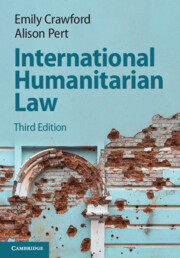Refine search
Actions for selected content:
149 results
Drought, Population Pressure, and Inequality Drive Intergroup Conflict in the Precontact North American Southwest
-
- Journal:
- American Antiquity , First View
- Published online by Cambridge University Press:
- 03 December 2025, pp. 1-19
-
- Article
-
- You have access
- Open access
- HTML
- Export citation
Chapter 4 - Homeric Emplotment and Themes
- from Part I - Herodotus and Epic Poetry
-
- Book:
- Herodotus and the Greek Poetic Tradition
- Published online:
- 04 November 2025
- Print publication:
- 06 November 2025, pp 93-145
-
- Chapter
- Export citation

Understanding International Security
- Theory and Practice
-
- Published online:
- 11 October 2025
- Print publication:
- 30 October 2025
-
- Textbook
- Export citation
Assessing the Predictive Value of mREMS in Patients with Trauma from the Syrian Civil War: A Retrospective Epidemiological Study
-
- Journal:
- Prehospital and Disaster Medicine / Volume 40 / Issue 5 / October 2025
- Published online by Cambridge University Press:
- 07 October 2025, pp. 243-250
- Print publication:
- October 2025
-
- Article
- Export citation
Stems, Barbs, and Knockdown Power: Bone Arrow Points from the Late Period of Sierras de Córdoba, Argentina
-
- Journal:
- Latin American Antiquity , First View
- Published online by Cambridge University Press:
- 27 August 2025, pp. 1-19
-
- Article
- Export citation
Chapter 5 - Conquest and Repatriation
-
- Book:
- Time and Governance in Fifteenth-Century Perpignan
- Published online:
- 26 July 2025
- Print publication:
- 14 August 2025, pp 164-209
-
- Chapter
- Export citation
5 - The Proper and Orthodox Way of War
-
- Book:
- Warriors in Washington
- Published online:
- 23 June 2025
- Print publication:
- 10 July 2025, pp 125-158
-
- Chapter
- Export citation
Chapter 7 - The Emergence of an Ars mensoria
- from Part IV
-
- Book:
- The <I>artes</I> and the Emergence of a Scientific Culture in the Early Roman Empire
- Published online:
- 22 March 2025
- Print publication:
- 13 February 2025, pp 316-371
-
- Chapter
- Export citation
Chapter 6 - The Character and Growth of the Latin Art of War
- from Part IV
-
- Book:
- The <I>artes</I> and the Emergence of a Scientific Culture in the Early Roman Empire
- Published online:
- 22 March 2025
- Print publication:
- 13 February 2025, pp 261-315
-
- Chapter
- Export citation
“The dear little flower babe has arrived!”: Blade stones, cradles, and child warriors in Ancient Mesoamerica
-
- Journal:
- Ancient Mesoamerica / Volume 36 / Issue 1 / April 2025
- Published online by Cambridge University Press:
- 09 January 2025, pp. 1-13
- Print publication:
- April 2025
-
- Article
-
- You have access
- HTML
- Export citation
6 - Fragile Empire
-
- Book:
- Fragile Empire
- Published online:
- 19 December 2024
- Print publication:
- 02 January 2025, pp 239-280
-
- Chapter
- Export citation
2 - Captives
-
- Book:
- Fragile Empire
- Published online:
- 19 December 2024
- Print publication:
- 02 January 2025, pp 68-112
-
- Chapter
- Export citation
Introduction
-
- Book:
- A Sociology of Post-Imperial Constitutions
- Published online:
- 06 December 2024
- Print publication:
- 12 December 2024, pp 1-37
-
- Chapter
- Export citation
8 - Religion
-
- Book:
- Charles Darwin
- Published online:
- 05 December 2024
- Print publication:
- 28 November 2024, pp 143-161
-
- Chapter
- Export citation
3 - Blood and Debt in Europe and Latin America
- from Part I - Puzzle and Argument
-
- Book:
- Bringing War Back In
- Published online:
- 14 November 2024
- Print publication:
- 21 November 2024, pp 50-78
-
- Chapter
- Export citation

International Humanitarian Law
-
- Published online:
- 25 October 2024
- Print publication:
- 09 May 2024
-
- Textbook
- Export citation
Technology and the Civilianization of Warfare
-
- Journal:
- Ethics & International Affairs / Volume 38 / Issue 1 / Spring 2024
- Published online by Cambridge University Press:
- 01 October 2024, pp. 64-74
-
- Article
-
- You have access
- Open access
- HTML
- Export citation
Warriors from the south? Arrowheads from the Tollense Valley and Central Europe
- Part of
-
- Article
-
- You have access
- Open access
- HTML
- Export citation
2 - Loss of Lives, Livelihoods and Love
- from Part I - Apocalypse No!
-
- Book:
- The Peace Formula
- Published online:
- 31 August 2024
- Print publication:
- 15 August 2024, pp 20-30
-
- Chapter
- Export citation
Chapter 5 - Rebuilding the 18th Infantry Brigade
-
- Book:
- Assault Brigade
- Published online:
- 25 October 2024
- Print publication:
- 12 August 2024, pp 96-112
-
- Chapter
- Export citation
